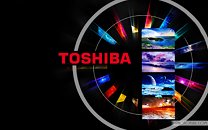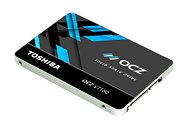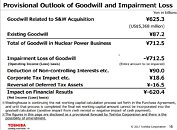Tuesday, February 14th 2017

Death By a Thousand Cuts: Toshiba to Sell Majority of its Semiconductor Business
Toshiba may not be dead in the water just yet, but news are dire for the company. After the companyconfirmed it was looking to spin-off its NAND production business so as to sell a minority, 20% stake for much-needed liquidity in the face of amounting debt and multiple management mistakes, reports now announce a much more aggressive stance from the company. It is now apparently looking to sell a majority stake (60%) on the spin-off, in the face of escalating costs and dwindling prospective chances.This comes in the wake of recent snags and strategic mistakes for the company, as we've previously reported - such as the $1.2 billion dollar accounting "misstated" earnings, which created difficulties for the company to refinance itself in the Tokyo Stock Exchange, and the gross miscalculation on the amount of debt of the CB&I Stone and Webster company that Toshiba acquired so as to facilitate its U.S.-based Westinghouse Electric nuclear plant subsidiary investment. This "miscalculation", where Toshiba considered the "goodwill" booking charges at $87 million and which were recently restated at a roughly-defined "several billion U.S. dollars." now stand at an eye-watering $6.3 billion.
For Toshiba, NAND flash production is strategically important because it enables the company to produce all types of storage devices in-house, allowing it to keep total production verticality, from product development, inception and design, all the way towards parts manufacturing and assembly - which leads to higher margins on each product sold. And it has to be said: selling of your most profitable business may be a short-term need, but it's surely a long-term risk. And with only a 40% stake in its most profitable business remaining, Toshiba stands to face difficult times.
The company is currently one of the world's largest NAND producers, and there are (as always) sharks hovering around the company. Tsinghua Unigroup, one of the branches of Chinese state-controlled Tsinghua University, has been listed as a possible investor. If successful in this investing effort, this would mean that Tsinghua (and through it, the Chinese government) would be able to achieve in-house semiconductor production. And this investment is looking ever more likely with Toshiba itself admitting to being wary of an investment from its partner WD, whose intervention could spark a long regulatory approval process, prospectively killing the immediacy of Toshiba's predicament.
Source:
Tom's Hardware
For Toshiba, NAND flash production is strategically important because it enables the company to produce all types of storage devices in-house, allowing it to keep total production verticality, from product development, inception and design, all the way towards parts manufacturing and assembly - which leads to higher margins on each product sold. And it has to be said: selling of your most profitable business may be a short-term need, but it's surely a long-term risk. And with only a 40% stake in its most profitable business remaining, Toshiba stands to face difficult times.
The company is currently one of the world's largest NAND producers, and there are (as always) sharks hovering around the company. Tsinghua Unigroup, one of the branches of Chinese state-controlled Tsinghua University, has been listed as a possible investor. If successful in this investing effort, this would mean that Tsinghua (and through it, the Chinese government) would be able to achieve in-house semiconductor production. And this investment is looking ever more likely with Toshiba itself admitting to being wary of an investment from its partner WD, whose intervention could spark a long regulatory approval process, prospectively killing the immediacy of Toshiba's predicament.




9 Comments on Death By a Thousand Cuts: Toshiba to Sell Majority of its Semiconductor Business
If absorbing losses from buying a dying company/product line means that you have to later sell your entire core business to cover said losses, then something is SERIOUSLY wrong in their accountant's office....
as with most things in that part of the world, somethin smells REALLY, REALLY fishy here :D
Toshiba's CEO was forced to resign in 2015 because they overstated their profits at Westinghouse:
in.reuters.com/article/us-toshiba-accounting-stocks-idINKCN0PV0B620150721
In 2015, Toshiba acquired CB&I Stone & Webster Inc. which is a nuclear power station construction company:
www.businesswire.com/news/home/20151027006999/en/Westinghouse-Acquires-CBI-Stone-Webster
In 2016, Toshiba was forced to write-down billions in losses because their projects in the USA were over time and over budget, CB&I was over valued, and Westinghouse in general was mismanaged:
www.reuters.com/article/us-toshiba-loss-idUSKBN15R01Z
Which brings us to today: Toshiba is selling their NAND business to try to raise capital to keep operating.
"Death by a thousand cuts" seems legit.